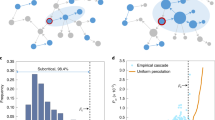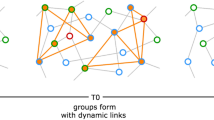Abstract
In computational social science, epidemic-inspired spread models have been widely used to simulate information diffusion. However, recent empirical studies suggest that simple epidemic-like models typically fail to generate the structure of real-world diffusion trees. Such discrepancy calls for a better understanding of how information spreads from person to person in real-world social networks. Here, we analyse comprehensive diffusion records and associated social networks in three distinct online social platforms. We find that the diffusion probability along a social tie follows a power-law relationship with the numbers of disseminator’s followers and receiver’s followees. To develop a more realistic model of information diffusion, we incorporate this finding together with a heterogeneous response time into a cascade model. After adjusting for observational bias, the proposed model reproduces key structural features of real-world diffusion trees across the three platforms. Our finding provides a practical approach to designing more realistic generative models of information diffusion.
This is a preview of subscription content, access via your institution
Access options
Access Nature and 54 other Nature Portfolio journals
Get Nature+, our best-value online-access subscription
$29.99 / 30 days
cancel any time
Subscribe to this journal
Receive 12 digital issues and online access to articles
$119.00 per year
only $9.92 per issue
Buy this article
- Purchase on Springer Link
- Instant access to full article PDF
Prices may be subject to local taxes which are calculated during checkout






Similar content being viewed by others
Data availability
Weibo and Twitter data are publicly available at https://www.dcjingsai.com/v2/cmptDetail.html?id=166 (in Mandarin) and https://snap.stanford.edu/data/higgs-twitter.html. LiveJournal data are subject to restrictions for user privacy protection. Interested readers should contact L. Muchnik (lev.muchnik@huji.ac.il) to gain access to the LiveJournal dataset.
Code availability
Custom code that supports the findings of this study is available at https://github.com/bnzu/main-code-of-rmis.
References
Watts, D. J. & Dodds, P. S. Influentials, networks, and public opinion formation. J. Consum. Res. 34, 441–458 (2007).
Rogers, E. M. Diffusion of Innovations (Simon and Schuster, 2010).
Leskovec, J., Adamic, L. A. & Huberman, B. A. The dynamics of viral marketing. ACM Trans. Web 1, 5 (2007).
Centola, D. The spread of behavior in an online social network experiment. Science 329, 1194–1197 (2010).
Aral, S. & Walker, D. Creating social contagion through viral product design: a randomized trial of peer influence in networks. Manag. Sci. 57, 1623–1639 (2011).
Newman, M., Barabási, A. L. & Watts, D. J. The Structure and Dynamics of Networks (Princeton Univ. Press, 2011).
Vosoughi, S., Roy, D. & Aral, S. The spread of true and false news online. Science 359, 1146–1151 (2018).
Iribarren, J. L. & Moro, E. Impact of human activity patterns on the dynamics of information diffusion. Phys. Rev. Lett. 103, 038702 (2009).
Salganik, M. J., Dodds, P. S. & Watts, D. J. Experimental study of inequality and unpredictability in an artificial cultural market. Science 311, 854–856 (2006).
Aral, S., Muchnik, L. & Sundararajan, A. Engineering social contagions: optimal network seeding in the presence of homophily. Netw. Sci. 1, 125–153 (2013).
Aral, S. & Walker, D. Identifying influential and susceptible members of social networks. Science 337, 337–341 (2012).
Kwak, H., Lee, C., Park, H. & Moon, S. What is Twitter, a social network or a news media? In Proc. 19th International Conference on World Wide Web 591–600 (ACM, 2010).
Gruhl, D., Guha, R., Liben-Nowell, D. & Tomkins, A. Information diffusion through blogspace. In Proc. 13th International Conference on World Wide Web 491–501 (ACM, 2004).
Liben-Nowell, D. & Kleinberg, J. Tracing information flow on a global scale using Internet chain-letter data. Proc. Natl Acad. Sci. USA 105, 4633–4638 (2008).
Goel, S., Anderson, A., Hofman, J. & Watts, D. J. The structural virality of online diffusion. Manag. Sci. 62, 180–196 (2015).
Goel, S., Watts, D. J. & Goldstein, D. G. The structure of online diffusion networks. In Proc. 13th ACM Conference on Electronic Commerce 623–638 (ACM, 2012).
Pei, S., Muchnik, L., Tang, S., Zheng, Z. & Makse, H. A. Exploring the complex pattern of information spreading in online blog communities. PLoS ONE 10, e0126894 (2015).
Muchnik, L., Aral, S. & Taylor, S. J. Social influence bias: a randomized experiment. Science 341, 647–651 (2013).
Bapna, R., Ramaprasad, J., Shmueli, G. & Umyarov, A. One-way mirrors in online dating: a randomized field experiment. Manag. Sci. 62, 3100–3122 (2016).
Eckles, D., Kizilcec, R. F. & Bakshy, E. Estimating peer effects in networks with peer encouragement designs. Proc. Natl Acad. Sci. USA 113, 7316–7322 (2016).
Centola, D. An experimental study of homophily in the adoption of health behavior. Science 334, 1269–1272 (2011).
Goldenberg, J., Libai, B. & Muller, E. Talk of the network: a complex systems look at the underlying process of word-of-mouth. Mark. Lett. 12, 211–223 (2001).
Watts, D. J. A simple model of global cascades on random networks. Proc. Natl Acad. Sci. USA 99, 5766–5771 (2002).
Castellano, C., Fortunato, S. & Loreto, V. Statistical physics of social dynamics. Rev. Mod. Phys. 81, 591 (2009).
Zhang, Z. K. et al. Dynamics of information diffusion and its applications on complex networks. Phys. Rep. 651, 1–34 (2016).
Pei, S. & Makse, H. A. Spreading dynamics in complex networks. J. Stat. Mech. 2013, P12002 (2013).
Domingos, P. & Richardson, M. Mining the network value of customers. In Proc. 7th ACM SIGKDD International Conference on Knowledge Discovery and Data Mining 57–66 (ACM, 2001).
Kempe, D., Kleinberg, J. & Tardos, É. Maximizing the spread of influence through a social network. In Proc. 9th ACM SIGKDD International Conference on Knowledge Discovery and Data Mining 137–146 (ACM, 2003).
Kitsak, M. et al. Identification of influential spreaders in complex networks. Nat. Phys. 6, 888–893 (2010).
Lü, L. et al. Vital nodes identification in complex networks. Phys. Rep. 650, 1–63 (2016).
Hu, Y. et al. Local structure can identify and quantify influential global spreaders in large scale social networks. Proc. Natl Acad. Sci. USA 115, 7468–7472 (2018).
Aral, S. & Dhillon, P. S. Social influence maximization under empirical influence models. Nat. Hum. Behav. 2, 375 (2018).
Pei, S., Wang, J., Morone, F. & Makse, H. A. Influencer identification in dynamical complex systems. J. Complex Netw. 8, cnz029 (2020).
Moreno, Y., Nekovee, M. & Pacheco, A. F. Dynamics of rumor spreading in complex networks. Phys. Rev. E 69, 066130 (2004).
Kermack, W. O. & McKendrick, A. G. A contribution to the mathematical theory of epidemics. Proc. R. Soc. Lond. A. 115, 700–721 (1927).
Pastor-Satorras, R., Castellano, C., Van Mieghem, P. & Vespignani, A. Epidemic processes in complex networks. Rev. Mod. Phys. 87, 925 (2015).
Iribarren, J. L. & Moro, E. Branching dynamics of viral information spreading. Phys. Rev. E 84, 046116 (2011).
Centola, D. & Macy, M. Complex contagions and the weakness of long ties. Am. J. Sociol. 113, 702–734 (2007).
De Domenico, M., Lima, A., Mougel, P. & Musolesi, M. The anatomy of a scientific rumor. Sci. Rep. 3, 2980 (2013).
Stephen, A. T., Dover, Y., Muchnik, L. & Goldenberg, J. Pump it out! The effect of transmitter activity on content propagation in social media. Saïd Business School WP https://doi.org/10.2139/ssrn.2897582 (2017).
Rodriguez, M. G., Gummadi, K. & Schoelkopf, B. Quantifying information overload in social media and its impact on social contagions. In Proc. 8th International AAAI Conference on Weblogs and Social Media 170–179 (AAAI, 2014).
Weng, L., Flammini, A., Vespignani, A. & Menczer, F. Competition among memes in a world with limited attention. Sci. Rep. 2, 335 (2012).
Gleeson, J. P., Ward, J. A., O’Sullivan, K. P. & Lee, W. T. Competition-induced criticality in a model of meme popularity. Phys. Rev. Lett. 112, 048701 (2014).
Feng, L. et al. Competing for attention in social media under information overload conditions. PLoS ONE 10, e0126090 (2015).
Hodas, N. O. & Lerman, K. How visibility and divided attention constrain social contagion. In Proc. 2012 International Conference on Privacy, Security, Risk and Trust and 2012 International Conference on Social Computing 249–257 (IEEE, 2012).
Lerman, K. Information is not a virus, and other consequences of human cognitive limits. Future Internet 8, 21 (2016).
Muchnik, L. et al. Origins of power-law degree distribution in the heterogeneity of human activity in social networks. Sci. Rep. 3, 1783 (2013).
Barabási, A. L. The origin of bursts and heavy tails in human dynamics. Nature 435, 207–211 (2005).
Akbarpour, M. & Jackson, M. O. Diffusion in networks and the virtue of burstiness. Proc. Natl Acad. Sci. USA 115, E6996–E7004 (2018).
Goldenberg, J., Han, S., Lehmann, D. R. & Hong, J. W. The role of hubs in the adoption process. J. Mark. 73, 1–13 (2009).
Mønsted, B., Sapieżyński, P., Ferrara, E. & Lehmann, S. Evidence of complex contagion of information in social media: an experiment using Twitter bots. PLoS ONE 12, e0184148 (2017).
Weng, L., Menczer, F. & Ahn, Y. Y. Virality prediction and community structure in social networks. Sci. Rep. 3, 2522 (2013).
Cheng, J., Adamic, L., Dow, P. A., Kleinberg, J. M. & Leskovec, J. Can cascades be predicted? In Proc. 23rd International Conference on World Wide Web 925–936 (ACM, 2014).
Pei, S., Muchnik, L., Andrade, J. S. Jr, Zheng, Z. & Makse, H. A. Searching for superspreaders of information in real-world social media. Sci. Rep. 4, 5547 (2014).
Efron, B. & Tibshirani, R. J. An Introduction to the Bootstrap (CRC Press, 1994).
Acknowledgements
B.Z. is funded by Natural Science Foundation of China (grant no. 61503159) and Jiangsu University Overseas Training Programme. S.P. is supported by NIH NIGMS grant no. 5U01GM110748. L.M. is supported by Israel Science Foundation grant no. 1777/17. X.M. and H.E.S. are supported by NSF Grant PHY-1505000 and DTRA grant no. HDTRA-1-14-1-0017. X.X. is supported by National Natural Science Foundation of China (grant no. 61773091). A.S. wishes to thank the Ariel Cyber Innovation Centre in conjunction with the Israel National directorate in the Prime Minister’s Office for their support. S.H. thanks the Italian Ministry of Foreign Affairs and International Cooperation jointly with the Israeli Ministry of Science, Technology, and Space (MOST); the Israel Science Foundation, ONR, the Japan Science Foundation with MOST, BSF-NSF, ARO, the Bar-Ilan University Centre for Research in Applied Cryptography and Cyber Security and DTRA (grant no. HDTRA-1-19-1-0016) for financial support. The funders had no role in study design, data collection and analysis, decision to publish or preparation of the manuscript.
Author information
Authors and Affiliations
Contributions
All authors designed the research. B.Z. and S.P. performed the experiments and analysis. B.Z., S.P. and L.M. curated data. B.Z., S.P. and L.M. wrote the first draft of the manuscript. X.M., X.X., A.S., S.H. and H.E.S. reviewed and edited the manuscript.
Corresponding authors
Ethics declarations
Competing interests
The authors declare no competing interests.
Additional information
Peer review information Primary handling editor: Aisha Bradshaw.
Publisher’s note Springer Nature remains neutral with regard to jurisdictional claims in published maps and institutional affiliations.
Supplementary information
Supplementary Information
Supplementary Tables 1–7 and Supplementary Figs. 1–8.
Rights and permissions
About this article
Cite this article
Zhou, B., Pei, S., Muchnik, L. et al. Realistic modelling of information spread using peer-to-peer diffusion patterns. Nat Hum Behav 4, 1198–1207 (2020). https://doi.org/10.1038/s41562-020-00945-1
Received:
Accepted:
Published:
Issue Date:
DOI: https://doi.org/10.1038/s41562-020-00945-1
This article is cited by
-
Diffusion capacity of single and interconnected networks
Nature Communications (2023)
-
An assessment of the contact rates between individuals when movement is modelled by a correlated random walk
Theoretical Ecology (2023)
-
Improving tobacco social contagion models using agent-based simulations on networks
Applied Network Science (2023)



